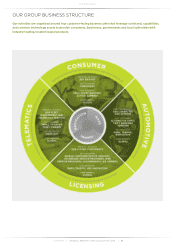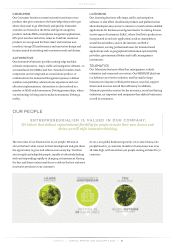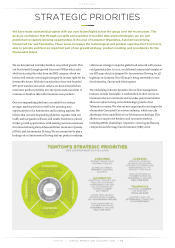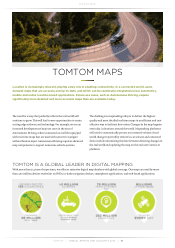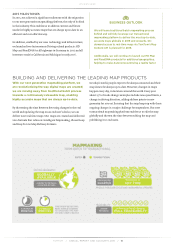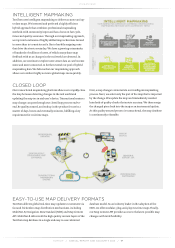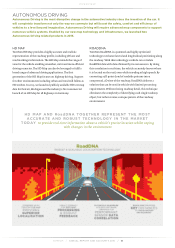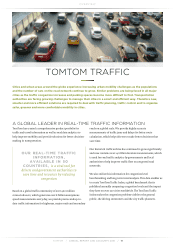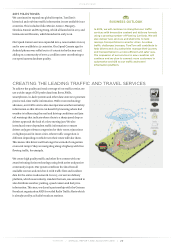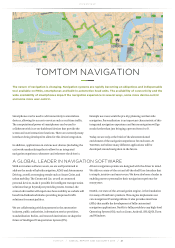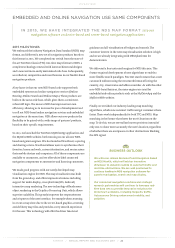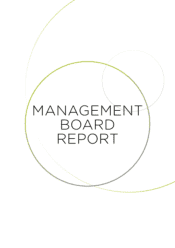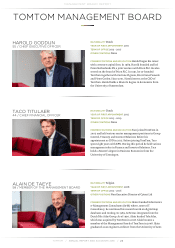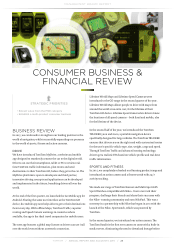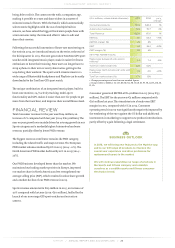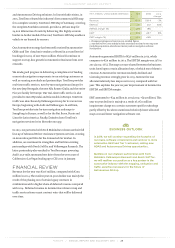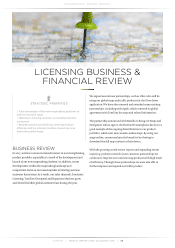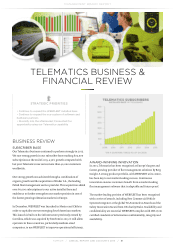TomTom 2015 Annual Report Download - page 22
Download and view the complete annual report
Please find page 22 of the 2015 TomTom annual report below. You can navigate through the pages in the report by either clicking on the pages listed below, or by using the keyword search tool below to find specific information within the annual report.
OVERVIEW
TOMTOM / ANNUAL REPORT AND ACCOUNTS 2015 / 21
TOMTOM NAVIGATION
The nature of navigation is changing. Navigation systems are rapidly becoming an ubiqutious and indispensable
tool available on PNDs, smartphones and built-in automotive head units. The availability of connectivity and the
wide availability of smartphones impact the navigation experience in several ways, some more device-centric
and some more user-centric.
Smartphones can be used to add connectivity to stand-alone
devices, allowing for access to services such as real-time traffic.
The computational power of smartphones can be used to
collaborate with in or on-dashboard devices that provide the
screen and user interaction functions. There are currently many
interfaces being developed to allow for this device integration.
In addition, applications on various user devices (including the
car) work seamlessly together to allow for an integrated
navigation experience, whenever and wherever the driver is.
Example use cases would be pre-trip planning and last mile
navigation. Personalisation is an important characteristic of this
integrated navigation experience and future navigation will go
much further than just bringing a person from A to B.
Today, we are only at the brink of the abovementioned
enrichment of the navigation experience for end users. At
TomTom, we believe many different applications will be
developed around navigation in the future.
A GLOBAL LEADER IN NAVIGATION SOFTWARE
With our mature software assets, we are well positioned to
address the needs of hybrid navigation, ADAS and Autonomous
Driving, as well as emerging trends such as Smart Cities, and
urban mobility. The Connected Car, as well as connected
personal devices, make it possible for intelligent transportation
solutions that go beyond just providing routes. Instead, the
connected traveller will experience how mobility as a whole will
benefit individuals while also providing improved traffic
solutions for municipalities.
We are collaborating with key partners in the automotive
industry, public authorities, information service providers,
standardisation bodies, and research institutions to shape the
future of Intelligent Transportation System (ITS).
All our navigation systems are designed with the driver in mind.
We deliver a state-of-the-art and off-the-shelf User Interface that
is simple, intuitive and easy-to-use. We have also been a leader in
enabling users to personalise their navigation experience for
many years.
NavKit, our state-of-the-art navigation engine, is the foundation
for many of TomTom's products. This engine implements our
core navigation IP and algorithms. It also provides interfaces
(APIs) that enable the development of fully customised
navigation applications. NavKit is fully portable to any high-level
Operating System (OS), such as Linux, Android, iOS, QNX, Tizen
and Windows.


